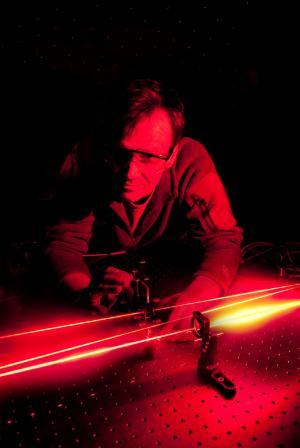Prestigious award for Professor Miles Padgett
Published: 7 November 2014
The Quantum Electronics and Optics Division of the European Physical Society has named Professor Miles Padgett as the 2015 winner of the Prize for Research into the Science of Light.
The Quantum Electronics and Optics Division of the European Physical Society has named Professor Miles Padgett as the 2015 winner of the Prize for Research into the Science of Light.
The prize is awarded every two years and recognizes a recent work by one or more (up to three) individuals for scientific excellence in the area of electromagnetic science in its broadest sense, across the entire spectrum of electromagnetic waves.

The Society chose to present the award to Professor Padgett, Kelvin Chair of Natural Philosophy in the School of Physics and Astronomy and Vice-Principal for Research, for “internationally recognised work on optical momentum, including an optical spanner, use of orbital angular momentum in communication systems and an angular form of EPR paradox”. The award is accompanied by an engraved glass medal, a certificate, and a monetary sum of 2000 euros.
The award will be presented in a special ceremony at the 5th International Topical Meeting on Nanophotonics and Metamaterials Conference (Nanometa 2015), which will take place in Seefeld, Austria, between the 5th and 8th of January, 2015. This meeting will start the EPS-supported European Conferences for the United Nations (UN) proclaimed 2015 International Year of Light and Light-based Technologies (www.light2015.org).
Professor Padgett’s group is internationally recognized for leadership in the field of optics and in particular of optical momentum. Their best-known contributions include an optical spanner for spinning micrometre-sized objects, use of orbital angular momentum to increase the data capacity of communication systems and an angular form of the Einstein–Podolsky–Rosen quantum paradox. In addition to opening a new field of optical research, recognition of orbital angular momentum has led to new directions in optics, where the spatial control of a light beam’s optical phase has driven areas as diverse as optical manipulation, quantum optics and imaging.
First published: 7 November 2014
<< November

